Our Husky UGV, released over 10 years ago, has been a steadfast companion in the robot and automation space, and it’s safe to say it has helped robotics researchers and developers around the world accomplish a lot over the years. With its versatile design and dependable performance, Husky has proven itself time and again in various industries. Join us as we reflect on some of the standout highlights from its journey, showcasing how this tried-and-true vehicle continues to make a significant impact.
2014
Robot Used For Lifesaving Humanitarian Research in Minesweeping
Clearpath robots automate dull, dirty and dangerous jobs, and University of Coimbra is using Husky with no exception to this vision. The team is researching and developing new methods for autonomous landmine clearance and we were thrilled to present them with the Special Award – Humanitarian Contribution as part of the 2012 Partnerbot Grant Program, inaugurated to support advancement in robotics research. Here’s how Coimbra is saving lives, one bot at a time.

2015
Husky Mobilizes MIT Bomb Disposal Research
Clearpath’s flagship robot, the Husky Unmanned Ground Vehicle (UGV), was conceptualized initially so humans could safely detect and remove land mines. True to those origins, Husky is now being used by Julie Shah’s team at the Massachusetts Institute of Technology (MIT) to research robotic intervention in a similarly deadly situation: bomb disposal. The team integrated Husky with RE2’s Highly Dexterous Manipulation System (HDMS) and is using the setup to test their teleautonomy interface. Their goal? Elevating human-robot communication to high-level commands like those you’d give to a human worker.

2017
Deployable, Autonomous Vibration Control of Bridges Using Husky UGV
Sriram Narasimhan’s research team is shaking things up in the Civil Engineering Structures Lab at the University of Waterloo. The research, which is led by Ph.D Candidate Kevin Goorts, is developing a new mobile damping system for suppressing unwanted vibrations in lightweight, flexible bridges. Whereas damping systems are often permanent fixtures built into the bridge, their system is designed to be adaptable, autonomous, and better suited for rapid, temporary deployment.

2018
Demine Robotics Uses Husky UGV in Landmine Excavating Device
Growing up in Cambodia, the world’s most heavily landmined country, demining is a cause that is very important to Richard Yim. This prompted Yim and four fellow mechnical engineering students at the University of Waterloo to develop a demining robot for a group project. In 2016, they started a company with a mission to reduce casualties in demining, which Yim describes as “the world’s most physically intensive field.” The robot uses the Husky UGV as a mobile base to hold and transport a landmine excavator.

Husky UGV Used for 3D Mapping In Mars Simulation
Graz University, in partnership with the Austrian Space Forum (OeWF) and international research organizations including Oman Astronomical Society, conducted a four-week Mars simulation mission in the Arabian desert in Oman. The Husky UGV was used for 3D mapping of the Oman terrain and transportation in the simulated mission, with the help of a 260 degree scanner laser. Once the Husky mapped environments, it was able to identify potential hazards, move around and collect data for the astronauts.

2019
Automating Construction Monitoring with Husky UGV and North Carolina State University
With the development of automation and robotics, the modernizing world has reached unprecedented levels of productivity. While this is best seen in industries like manufacturing, others, like construction, have struggled to see the same dramatic improvement. A team of researchers from the Construction Automation and Robotics Lab (CARL) at North Carolina State University, in collaboration with the Active Robotic Sensing (ARoS) Laboratory and the Laboratory for Interpretable Visual Modeling, Computing and Learning (iVMCL), believes that the lack of advanced automation in construction is to blame.

2020
Researchers Advance Robot Teleoperation in Hazardous Environments with Husky UGV
Guy Zaidner and Dr Mitch Pryor are researchers from The University of Texas at Austin who have developed Vaultbot – a Husky-based robot built to improve situational awareness in the teleoperation of dual-arm mobile robots, specifically in hazardous and uncertain environments.

2021
Heriot-Watt University Develops Autonomous Environments For Offshore Energy Sector
The Smart Systems Group from the Heriot-Watt University in Edinburgh is working to promote sustainability and to create resilience in systems, organizations, networks, and societies. Their projects include collaboration with a global network of academic and industrial partners to deliver the flexibility, resilience, and sustainability that our global infrastructure requires. The work was completed in collaboration with the Offshore Robotics for the Certification of Assets (ORCA) Hub, MicroSense Technologies Ltd, and Offshore Renewable Energy Catapult.

Technical University of Denmark Enhances Organic Farming With Robotic Weeder
In crop cultivation, plants are clearly separable from the soil by parameters such as color thresholding or by considering near-infrared (NIR) imagery (which has higher reflectivity on chlorophyll content). However, in grasslands, weeds and background plants share similar colors and chlorophyll content, therefore, making dataset creation more expensive and weed detection more challenging. To tackle such a challenge, a team of researchers from the Technical University of Denmark is using Husky UGV to develop an agricultural robot platform that removes grassland weeds within organic dairy farming without the usage of herbicides.

Behind the Robot: HITT’s Construction Site Monitoring Husky UGV
“S.A.M.”, using a Husky UGV base, is a project specifically designed for HITT’s developing internal robotics program for their site operations teams in order to equip them with the necessary tools to extend their presence on a job site, increase the team member experience, and even attract more people to field careers. Specifically, “S.A.M.” will be used as a communication intermediary, connecting a superintendent with a subcontractor from across a job site through two-way communications. It will also be able to traverse the site to remotely inspect work in place and capture progress photography and video.

2022
European Institute of Technology Improves Mine Safety With Intelligent Inspection Robot
Underground mines are hazardous working environments that put human lives at risk while the operators must be trained and often take a long time to reach the spot that must be scanned. For years, researchers and roboticists alike have been working to develop autonomous systems to alleviate many of the concerns regarding working in mines. However, considerations outside of immediate safety, utility, and productivity are often disregarded. In order to address many of these deficiencies within the mining industry and in order to develop a better future for robots in this space, a series of partners led by DMT GmbH & Co. KG created a European Institute of Technology (EIT) Research Project named UNDROMEDA – Underground Robotic System for Monitoring, Evaluation and Detection Applications.

Research Team Advances Penguin Conservation Research With Robotics In Antarctica
With over a year since our 2020 PartnerBot grant program, we’ve been itching to catch up with our winners and their exciting research. We can’t wait to tell you about another adventure that brings us to a rarely traveled region of the world: Antarctica. The Woods Hole Oceanographic Institution (in collaboration with Friedrich Alexander University Erlangen-Nuremberg, CNRS Strasbourg, CSM Monaco, and the Alfred Wegener Institute for Polar and Marine Research) seeks to reduce the human impact on biodiversity by monitoring emperor penguin colonies with the inconspicuous and unobtrusive eye of Husky UGV.

2023
University of Michigan Develops Localization Algorithm for Unstructured Environments
The University of Michigan‘s Computational Autonomy and Robotics Laboratory (CURLY) Lab’s most recent project employed a Husky UGV and was undertaken to improve the current state of autonomous mobile robots. The CURLY Lab has succeeded with autonomous robotic systems in urban settings (e.g., self-driving cars and delivery robots). However, robotic systems continue to face challenges when operating in unstructured environments such as forests or mountains. The group then concentrates on developing algorithms that will allow robotic systems to operate in harsh environments. Such technology will aid in search and rescue, first-responder missions, and scientific exploration.

Poznań University of Technology Explores AI & Robotics in Space Research
In the competitive space sector, reducing overall cost while yielding substantial results from space missions is becoming increasingly important. For this reason, researchers are now exploring cost-effective on-board rover processing by using commercial off-the-shelf parts. So is the purpose of project Cognition, being developed by the company KP Labs, the Computer Vision Lab and the Perception for Physical Interaction Lab at Poznań University of Technology.

University of Texas at Arlington Employs Husky UGV For Automated Plant Phenotyping
There is an urgent need for advanced technologies, such as robotics and computer vision, that can precisely capture plant phenotypes. With the advent of these technologies, wide scale genomic selection and cotton breeding can be undertaken. To achieve this goal, a team of researchers at the Robotic Vision Laboratory (RVL) at the University of Texas at Arlington is using Husky UGV for automated cotton phenotyping.

Learn more about Husky here.

